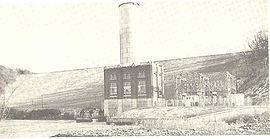
Surge tank
Encyclopedia

Reservoir
A reservoir , artificial lake or dam is used to store water.Reservoirs may be created in river valleys by the construction of a dam or may be built by excavation in the ground or by conventional construction techniques such as brickwork or cast concrete.The term reservoir may also be used to...
at the downstream end of a closed aqueduct
Aqueduct
An aqueduct is a water supply or navigable channel constructed to convey water. In modern engineering, the term is used for any system of pipes, ditches, canals, tunnels, and other structures used for this purpose....
or feeder pipe to absorb sudden rises of pressure
Water hammer
Water hammer is a pressure surge or wave resulting when a fluid in motion is forced to stop or change direction suddenly . Water hammer commonly occurs when a valve is closed suddenly at an end of a pipeline system, and a pressure wave propagates in the pipe...
as well as to quickly provide extra water during a brief drop in pressure. An open tank to which the top of a surge pipe is connected so as to avoid loss of water during a pressure surge.
In mining technology, ore pulp pumps use a relatively small surge tank to maintain a steady loading on the pump.
For hydroelectric power uses, a surge tank is an additional storage space or reservoir fitted between the main storage reservoir and the power house (as close to the power house as possible). Surge tanks are usually provided in high or medium-head
Hydraulic head
Hydraulic head or piezometric head is a specific measurement of water pressure above a geodetic datum. It is usually measured as a water surface elevation, expressed in units of length, at the entrance of a piezometer...
plants when there is a considerable distance between the water source and the power unit, necessitating a long penstock.
The main functions of the surge tank are:
1. When the load decreases, the water moves backwards and gets stored in it.
2. When the load increases, additional supply of water will be provided by surge tank.
In short, the surge tank mitigates pressure variations due to rapid changes in velocity of water.
Operation
Consider a pipe containing a flowing fluid. When a valve is either fully or partially closed at some point downstream, the fluid will continue to flow at the original velocity. In order to counteract the momentum of the fluid the pressure will rise significantly (pressure surge) just upstream of the control valve and may result in damage to the pipe system. If a surge chamber is connected to the pipeline just upstream of the valve, on valve closure the fluid instead of being stopped suddenly by the valve will flow upwards into the chamber hence reducing the surge pressures experienced in the pipeline.Upon closure of the valve, the fluid continues to flow, passing into the surge tank causing the water level in the tank to rise. The level in the tank will continue to rise until the additional head due to the height of fluid in the tank balances the surge pressure in the pipeline. At this point the flow in the tank and pipeline will reverse causing the level in the tank to drop. This oscillation in tank height and flow will continue for some time but its magnitude will dissipate slowly due to the effects of friction.

